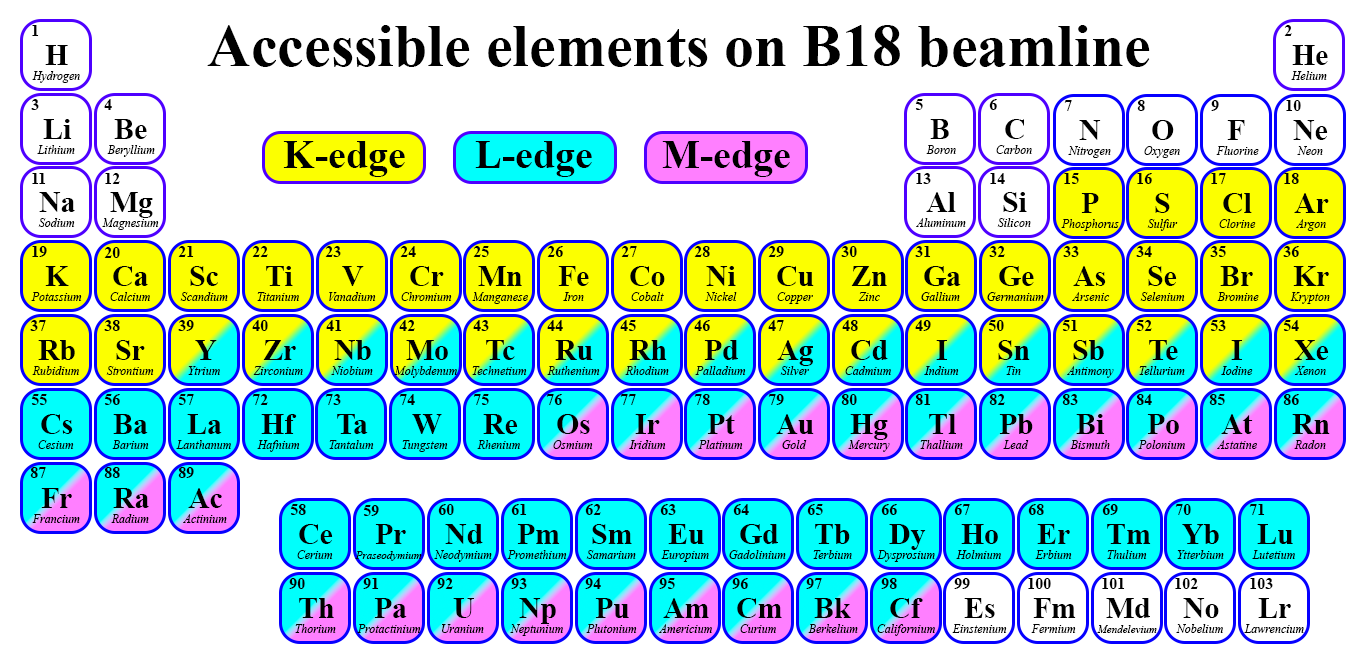B18 Contact
Beamline Phone Number:
+44 (0) 1235 778695
Beamline E-mail:
Principal Beamline Scientist:
Diego Gianolio
Tel: +44 (0) 1235 778228
E-mail: [email protected]
Science Group Leader
Email: [email protected]
Tel: +44 (0) 1235 778158
B18 is a general purpose XAS beamline on Diamond, being part of an integrated project devoted to XAS, which includes I18, a Microfocus beamline based on an undulator source (2-20 keV), and I20, a high flux versatile multi-pole wiggler, (4-35 keV). The Core-XAS beamline naturally complements the specialized activities undertaken at the other XAS beamlines, allowing experiments with more general and less demanding specifications, preliminary studies, and open to the access of one-time and new users.
Beamline B18 covers the energy ranges of both I18 and I20. It is used for an extensive range of studies that underpin research programmes across a wide range of applications, including local structure and electronic state of active components, and the study of materials including fluids, crystalline and non-crystalline (amorphous phases & colloids) solids, surfaces and biomaterials.
| Energy Range | 2.05-35 keV |
| Energy resolution (Δ E/E) | Si 111: 1.4 x 10-4 (2.05-20 keV) Si 311: 3 x 10-5 (4-35 keV) |
| Flux @ 8 keV at sample (ph/s, Si111) | 5x1011 |
| Beam size at sample (µm) |
Defocused (standard): 1000(H) x 1000(V) Focused: down to 200 (H) x 250 (V) |
| Beam divergence at sample (mrad) (FWHM) | 1.9 (H) x 0.22 (V) |
| Standard scanning time (QuickEXAFS mode) | 3-5 min, with an energy step ~0.3eV |
The beam source is a Diamond Bending Magnet. B18 Front End will allow the collection of about 3mrad (H) x 0.14 mrad (V) radiation.
| Electron energy | 3 GeV |
| Beam current | 300 mA (w. upgrade to 500 mA) |
| Beam emittance | 2.7 nm.rad |
| Electron beam (rms) dimensions s x, , s y s x’ , s y’ |
53.7 m m, 23.7 m m 81.4 m rad, 2.6 m rad |
| Dipole magnetic field | 1.4 T |
| Dipole bending radius | 7.148 m |
| Critical energy | 8.39 keV |
| Photon flux at 10 keV [ph/sec/mrad/0.1%BW/300mA] | 1.3 x 1013 |
| Brightness at 10 keV [ph/sec/mm2/ mrad2/0.1%BW/300mA] | 3.8 x 1015 |
| Dipole power per horizontal angle |
47.9 W/mrad (80 W/mrad @500mA) |
| On axis power density | 184.4 W/mrad2 (307 W/mraAd2 @500m) |

Diamond Light Source is the UK's national synchrotron science facility, located at the Harwell Science and Innovation Campus in Oxfordshire.
Copyright © 2022 Diamond Light Source
Diamond Light Source Ltd
Diamond House
Harwell Science & Innovation Campus
Didcot
Oxfordshire
OX11 0DE
Diamond Light Source® and the Diamond logo are registered trademarks of Diamond Light Source Ltd
Registered in England and Wales at Diamond House, Harwell Science and Innovation Campus, Didcot, Oxfordshire, OX11 0DE, United Kingdom. Company number: 4375679. VAT number: 287 461 957. Economic Operators Registration and Identification (EORI) number: GB287461957003.